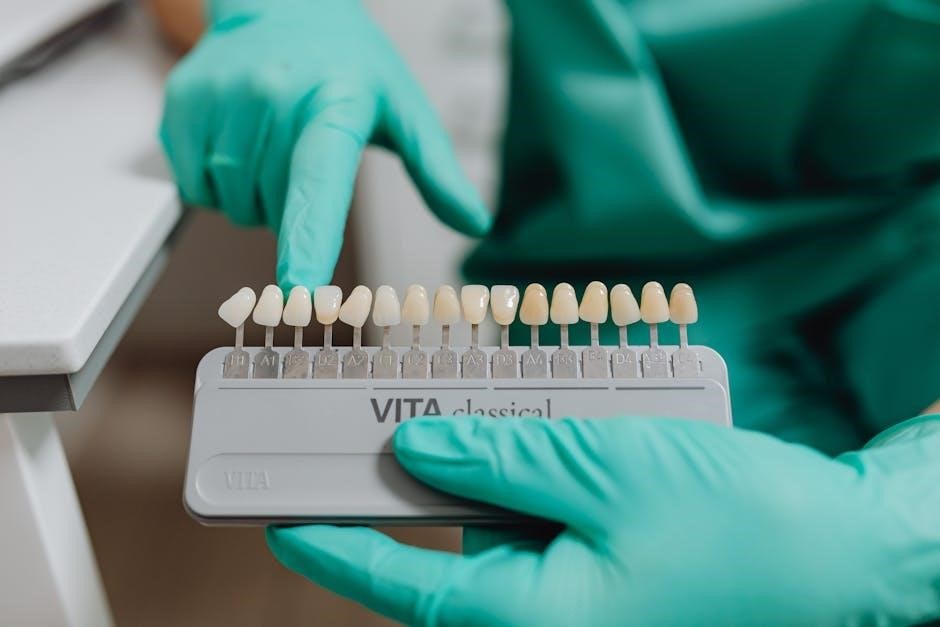
A Teeth Whitening Shade Guide is a tool used to measure and match tooth color, aiding in achieving desired whitening results. It standardizes color matching, ensuring accurate and predictable outcomes.
1.1 What is a Teeth Whitening Shade Guide?
A Teeth Whitening Shade Guide is a specialized dental tool used to measure and match tooth color, aiding in achieving desired whitening results. It typically consists of a chart or set of samples with different shades, ranging from yellowish to white, each with specific codes or numbers. This guide is not only essential for teeth whitening but also for procedures like crowns or veneers, where matching natural tooth color is crucial. Available in various types and brands, such as the Vita Toothguide 3D Master, these guides may be physical charts or digital software, offering precise color matching for predictable outcomes. Some guides include features like mirror cases for convenience during consultations. They often feature 20 shades with laser-engraved numbering, ensuring accurate tracking of color changes. The guide helps set realistic expectations for patients, showing potential shade improvements, and is a practical tool in clinical settings. It enhances patient communication and decision-making, providing a visual understanding of treatment possibilities. Ultimately, a Teeth Whitening Shade Guide is vital for both aesthetics and clinical accuracy, ensuring seamless integration of dental work with natural teeth.
1.2 Importance of Shade Guides in Teeth Whitening
A Teeth Whitening Shade Guide is crucial for achieving accurate and predictable results. It helps dentists and patients communicate effectively, ensuring aligned expectations. By standardizing tooth color measurement, it simplifies treatment planning and monitoring. Shade guides also document progress, motivating patients by showing noticeable improvements. They enhance professionalism and precision, making them indispensable in modern dental aesthetics for both whitenings and restorative procedures.

Types of Teeth Whitening Shade Guides
Teeth Whitening Shade Guides come in classical and modern types, offering physical charts and digital tools. They range from traditional Vita scales to advanced 3D and laser-guided systems.
2.1 Classical vs. Modern Shade Guides
Classical shade guides, like the Vita Classical, use traditional tooth color charts with limited shades. In contrast, modern guides offer advanced features such as 3D resin teeth and digital tools for precise matching. Classical guides are simple and cost-effective, while modern ones provide enhanced accuracy and customization, catering to diverse patient needs and aesthetic goals in teeth whitening treatments.
2.2 Digital vs. Physical Shade Guides
Digital shade guides use advanced technology for precise color matching, often with apps or real-time data. They offer enhanced accuracy and storage capabilities. Physical guides, like traditional charts, are portable and cost-effective. While digital tools provide modern convenience, physical guides remain popular for their simplicity and tactile experience, each catering to different clinical preferences and patient needs in teeth whitening procedures.
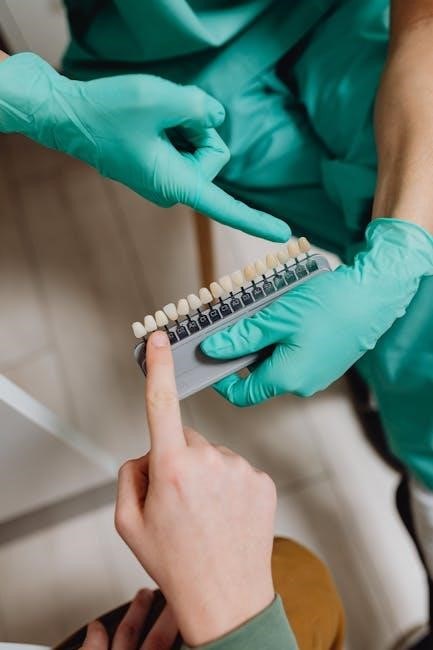
How to Use a Teeth Whitening Shade Guide
A teeth whitening shade guide helps professionals and patients match tooth color accurately. It involves comparing the natural tooth shade with the guide to determine the desired whiteness level, ensuring realistic and achievable outcomes while tracking progress throughout the whitening process.
3.1 Step-by-Step Process for Accurate Shade Matching
Start by preparing the teeth under natural light, ensuring they are clean and dry. Compare the natural tooth color with the shade guide, matching the closest shade. Document the initial shade for reference. Use the guide to set realistic whitening goals with the patient. After treatment, reassess and track progress using the same guide to monitor shade transformation and achieve desired results effectively.
3.2 Tips for Effective Shade Comparison
For accurate shade comparison, use natural light and ensure teeth are clean and dry. Compare shades in a neutral environment to minimize color distortion. Utilize modern guides like the Vita Classical Shade Guide for precise matching. Consider the patient’s natural tooth color and desired outcome. Document initial and target shades for clear communication. Regularly update comparisons to track progress and ensure satisfying results for both patients and professionals.

Clinical Significance of Teeth Whitening Shade Guides
Teeth Whitening Shade Guides are essential for accurate color matching and documentation. They help monitor progress, ensure patient satisfaction, and maintain consistent results in dental whitening procedures.
4.1 Role in Dental Assessments and Treatment Planning
Teeth Whitening Shade Guides play a crucial role in dental assessments by providing a standardized reference for tooth color. They help dentists document initial tooth shades, set realistic expectations, and plan personalized treatment. By comparing pre- and post-whitening shades, professionals can monitor progress and adjust treatments. This tool also aids in matching natural tooth colors for restorations, ensuring seamless integration with veneers, implants, or other cosmetic procedures. Accurate shade matching enhances overall treatment outcomes and patient satisfaction.
4.2 Enhancing Patient Communication and Satisfaction
Teeth Whitening Shade Guides improve patient communication by providing a visual reference for discussing treatment goals. They allow patients to see potential results, fostering realistic expectations. Dentists can use the guide to demonstrate achievable shade changes, ensuring alignment with patient desires. This transparency builds trust and satisfaction, as patients feel involved in their care. The guide also helps in personalizing treatment plans, enhancing the overall dental experience and patient outcomes.
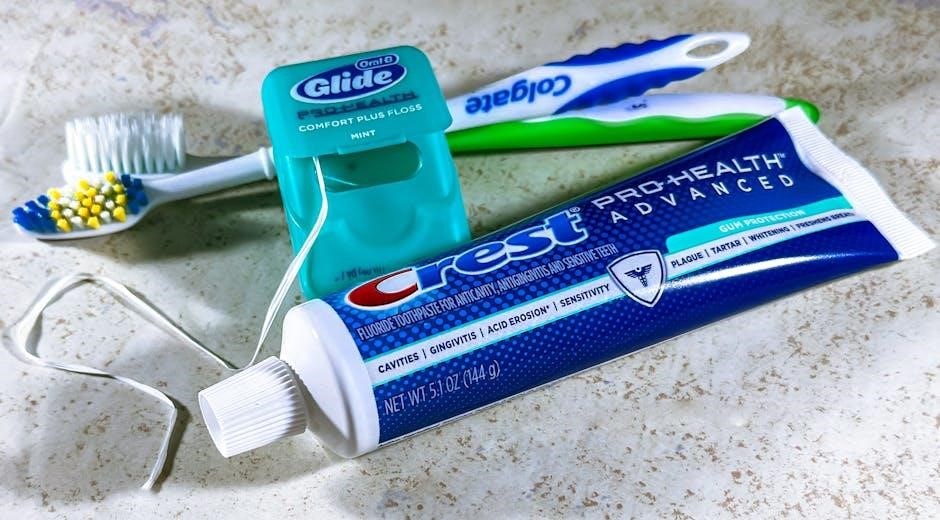
Factors Affecting Tooth Color and Shade Selection
Tooth color is influenced by intrinsic and extrinsic factors, such as staining from food, lifestyle habits, and genetic traits. These elements impact shade selection, ensuring personalized results.
5.1 Intrinsic vs. Extrinsic Tooth Staining
Intrinsic stains occur within the tooth, caused by genetics, aging, or trauma, affecting enamel and dentin. Extrinsic stains are surface-level, resulting from food, smoking, or poor hygiene. Understanding these differences is crucial for effective whitening, as intrinsic stains may resist treatment and require advanced methods, while extrinsic stains typically respond well to standard bleaching procedures.
5.2 Impact of Lifestyle and Genetics on Tooth Color
Lifestyle factors like diet, smoking, and oral hygiene significantly influence tooth color. Foods such as coffee, tea, and red wine can cause extrinsic stains, while genetics determine intrinsic tooth color variability. Thinner enamel or naturally yellower dentin, often due to hereditary traits, affects base color. These elements must be considered when selecting shades for whitening, as they influence both starting points and achievable results.
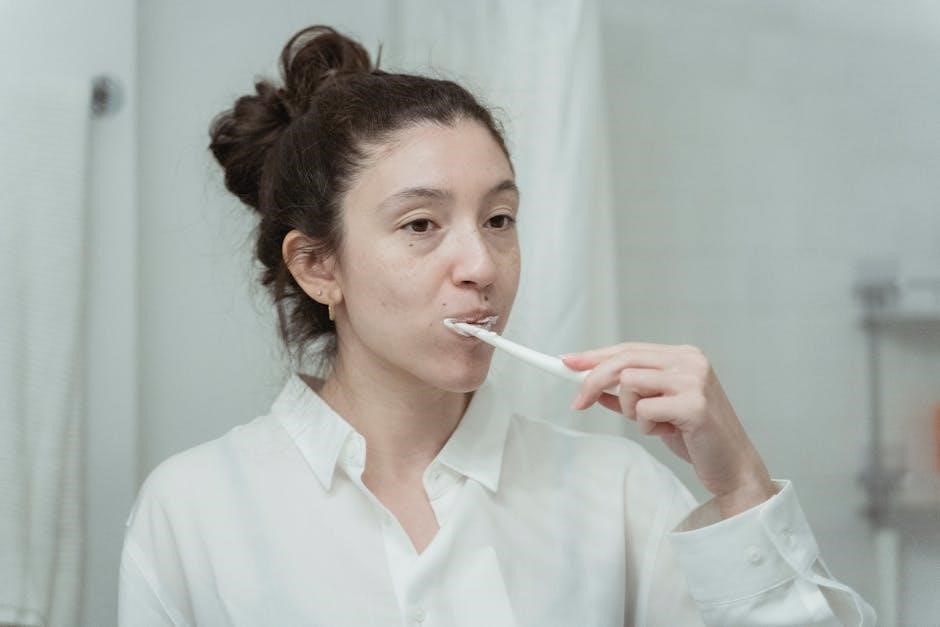
Teeth Whitening Process and Shade Guide Application
The teeth whitening process begins with an initial consultation to assess tooth color using a shade guide. This step helps set realistic expectations and monitor progress effectively.
6.1 Initial Consultation and Shade Assessment
During the initial consultation, dentists use a teeth whitening shade guide to assess the patient’s current tooth color. This step involves comparing the natural shade of the teeth to the guide’s standardized colors. The dentist discusses the patient’s expectations, explains possible outcomes, and selects a target shade. This process ensures personalized treatment planning and sets realistic goals for the whitening procedure, enhancing patient communication and satisfaction.
6.2 Monitoring Progress with Shade Guides
Shade guides are essential for tracking progress during teeth whitening treatments. By comparing the patient’s tooth color before, during, and after treatment, dentists can accurately measure improvements. Regular assessments using the guide help adjust the treatment plan and ensure desired results. This systematic approach also motivates patients by visually demonstrating their progress, fostering better communication and satisfaction throughout the whitening journey.
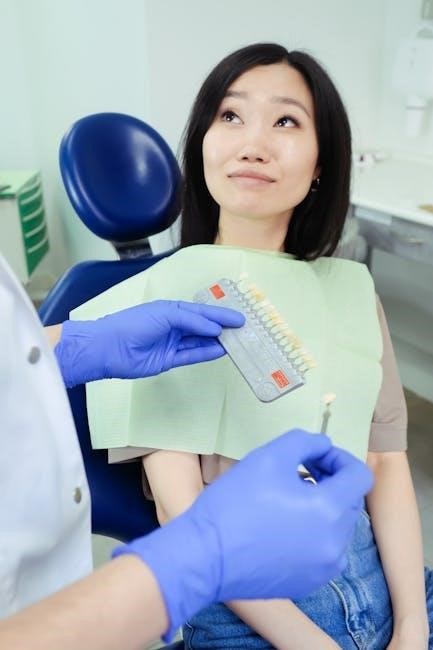
Expected Results and Shade Transformation
Teeth whitening typically results in a 2-7 shade improvement, sometimes more. Shade guides help predict and achieve desired transformations, ensuring realistic expectations for patients.
7.1 Average Shade Change in Teeth Whitening
On average, teeth whitening can result in a 2-7 shade improvement, with most patients experiencing a 4-6 shade change. Shade guides help track this progress, ensuring accurate documentation. Individual results vary based on tooth condition, staining depth, and treatment type. While some achieve dramatic transformations, others may see subtle changes. Using a shade guide helps set realistic expectations and monitor the whitening journey effectively.
7.2 Factors Influencing the Outcome of Whitening
The outcome of teeth whitening is influenced by several factors, including the original tooth color, which is often determined by genetics and lifestyle. Intrinsic and extrinsic stains also play a role, with deeper stains being harder to remove. The effectiveness of the whitening method, concentration of the product, and enamel thickness are additional determinants. Compliance with treatment and maintenance routines further impact the final result.
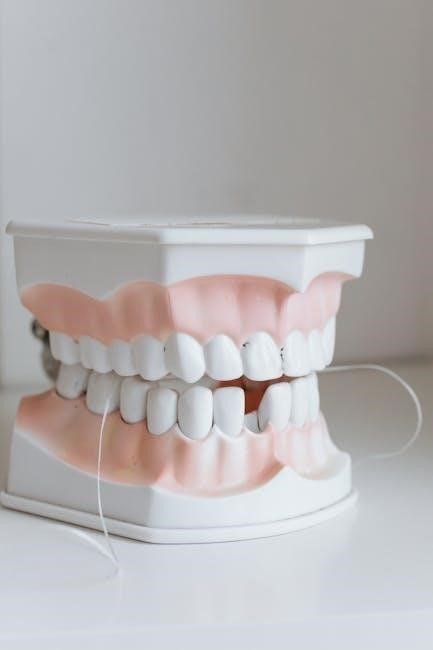
Maintenance and Aftercare for Whitened Teeth
Regular dental check-ups, avoiding stain-causing foods, and using straw for beverages help maintain whiteness. Touch-ups and good oral hygiene ensure long-lasting results and a brighter smile.
8.1 Lifestyle Changes to Preserve Whiteness
Minimize consumption of staining foods like coffee, tea, and red wine. Use a straw for beverages to reduce tooth contact. Quit smoking or tobacco products, as they discolor teeth. Maintain good oral hygiene with regular brushing and flossing. Limit sugary snacks to prevent acid erosion. Consider touch-up treatments periodically to maintain brightness and combat natural discoloration over time.
8.2 Professional Touch-Ups and Follow-Ups
Regular professional touch-ups are essential to maintain whitening results. Schedule follow-up appointments with your dentist to monitor progress and address any discoloration. Professional treatments can reinforce results, ensuring long-lasting brightness. Additionally, using products recommended by your dentist can help preserve whiteness. Consistent follow-ups prevent stains from reappearing and keep your smile radiant, making professional maintenance a key part of sustaining your teeth whitening outcomes.

Cost Implications of Using a Teeth Whitening Shade Guide
Investing in a professional teeth whitening shade guide ensures precise color matching, enhancing treatment outcomes. Costs vary, but high-quality guides with advanced features like mirrors justify the expense for accurate results.
9.1 Investment in Professional Shade Guides
Professional teeth whitening shade guides are a valuable investment for dentists and patients alike. They offer accurate color matching, ensuring precise treatment outcomes. High-quality guides, such as those with mirrors or 3D resin teeth, provide durability and enhance clinical decision-making. While initial costs may seem high, their long-term benefits, including improved patient satisfaction and efficient results, make them a worthwhile expense for achieving optimal whitening success.
9.2 Cost-Effectiveness of Accurate Shade Matching
Accurate shade matching is a cost-effective approach in teeth whitening, reducing the need for retries and enhancing patient satisfaction. Professional guides minimize errors, ensuring treatments align with expectations. This streamlines the process, saving time and resources. While initial costs for high-quality tools may seem steep, their precision and long-term efficiency make them a valuable investment, optimizing outcomes and patient referrals.
A teeth whitening shade guide is essential for achieving desired results, ensuring accuracy and patient satisfaction. It streamlines the whitening process, making it a vital tool in modern dentistry.
10.1 Summary of Key Points
A teeth whitening shade guide is a crucial tool for achieving precise color matching and predictable outcomes. It offers a range of shades, from natural to ultra-white, catering to individual preferences. Modern guides feature 3D resin teeth and digital tools for enhanced accuracy. They aid in tracking progress, communicating with patients, and ensuring satisfying results. Their versatility extends beyond whitening, supporting veneers, crowns, and other dental procedures. By standardizing color selection, shade guides simplify the whitening process, making them indispensable in modern dentistry.
10.2 Final Thoughts on the Importance of Shade Guides
Teeth whitening shade guides are indispensable for achieving precise, predictable results. They ensure accurate color matching, enhance patient communication, and boost satisfaction. Modern guides offer versatility, catering to various dental needs beyond whitening. Investing in professional tools like 3D resin or digital guides elevates treatment outcomes, making shade guides a cornerstone in modern dentistry for both clinical and aesthetic success.
 bottom guide for sliding shower doors
bottom guide for sliding shower doors  harvest right troubleshooting guide
harvest right troubleshooting guide  tails noir trophy guide
tails noir trophy guide  san francisco travel guide map
san francisco travel guide map  antenna tv guide austin tx
antenna tv guide austin tx  act math study guide pdf
act math study guide pdf  king of the underworld rj kane pdf
king of the underworld rj kane pdf  merlin home transmitter manual
merlin home transmitter manual  contrat de sous-location québec pdf
contrat de sous-location québec pdf  mark cousins the story of film pdf
mark cousins the story of film pdf